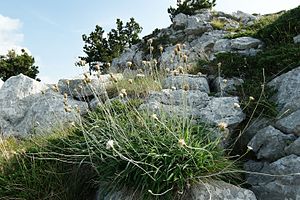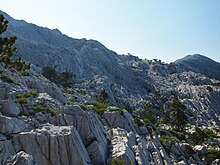Neumayer jug fruit
| Neumayer jug fruit | ||||||||||||
|---|---|---|---|---|---|---|---|---|---|---|---|---|

Neumayer jug fruit ( Amphoricarpos neumayerianus ) |
||||||||||||
| Systematics | ||||||||||||
|
||||||||||||
| Scientific name | ||||||||||||
| Amphoricarpos neumayerianus | ||||||||||||
| ( Vis. ) Greuter |
The Neumayer Krug fruit ( Amphoricarpos neumayerianus ) is a species of the genus in the subfamily of Carduoideae within the family of Compositae (Asteraceae). It is endemic to the western and southern Balkan Peninsula .
description
Vegetative characteristics
The Neumayer jug fruit is a perennial herbaceous plant and usually reaches heights of 20 to 50 (13 to 65) centimeters. It forms a short woody taproot . The independently upright to overhanging (in plant specimens that grow in steep walls) stems are hairy whitish.
The leaves of the leaf rosettes are opposite, usually 0.25 to 0.50 (0.15 to 0.65) times as long as the stems. The basal leaves are green on top, glabrous to slightly hairy, and white wool on the bottom. They are narrowed to a short stalk at their base or almost sessile. Their leaf blades are usually 7 to 20 (5 to 23) centimeters long and usually 6 to 22 (5 to 32) millimeters wide, 5 to 25 (3 to 40) times longer than broad and lanceolate to ovoid, elliptical or oblong-obovate, entire, with a flat or up to 1.3 mm twisted edge and ending in a point.
The usually 4 to 7 (3 to 10) stem leaves are arranged alternately. Their leaf blades are linear to lanceolate, rarely lanceolate-obovate, whole and smaller; the bottom is 6 to 32 (1.5 to 40) times longer than wide, 4 to 17 (1.4 to 22) centimeters long, usually 4 to 14 (2 to 18) millimeters wide, whole and with a flat or twisted edge and ending in a point; the hairiness is similar to that of the basal leaves.
Generative characteristics
The flower heads stand individually or rarely in pairs or in groups of four. They have a diameter of 1.5 to 2, rarely up to 2.5 centimeters. The bracts are mostly elongated-ovate to ovate-spherical, in the third row usually 1.2 to 2 (1 to 2.5) times as long as wide, usually 4.5 to 8 (4 to 9.5) millimeters long and usually 3 to 4.5 (2.6 to 5) millimeters wide, mostly curved with hooks, with a 0.35 to 0.8 (0.2 to 0.95) millimeter wide membrane. The receptaculum is convex, with whole or fringed scales.
The flowers are pink to whitish.
The achenes are usually 4.5 to 7.5 (3.5 to 8.5) millimeters long, barely to densely hairy, ribbed, the outer flattened, the inner cylindrical. The outer achenes usually have 0.2 to 0.6 (0.1 to 0.8) millimeter wide wings and usually 0.2 to 1.1 (0.1 to 1.4) millimeter long auricles. The pappus is usually 6 to 10 (4.5 to 11) millimeters long.
Chromosome number
The number of chromosomes is 2n = 24.
distribution

The discontinuous area includes the mountainous regions of the Dinarides between the Vlašić in Bosnia and Herzegovina to the Tymfi in the Pindus in Greece . It is found in Albania , Bosnia and Herzegovina, Greece, Macedonia , Montenegro, and Serbia .
Plant sociology

The Neumayer jug fruit is a pronounced chasmophyte and limestone rock species. It is at the same time the character and name-giving species of the Dinaric subalpine and oro-Mediterranean crevice-order Amphoricarpetalia .
Due to the discontinuous widespread distribution and the numerous local endemisms of individual Balkan mountain groups, the Neumayer jug fruit is widespread in numerous plant-sociological associations. The order Amphoricarpetalia Lakušić belongs to the class of European rock vegetation Asplenietea rupestris Br.-Bl. 1943 and is a separate order of the carbonate rock corridors.
In the Sub-Adriatic Southeast Dinarides, the Amphoricarpion neumayeri Lkšić association was established. designated, which leads between the rock corridors of the orders Amphoricarpetalia and Moltkeetalia in which thermophilic species of Mediterranean and sub-Mediterranean origin occur. The association Amphoricarpion bertiscei Lakušić was described from the more continental High Dinars. This includes numerous Illyrian cold-tolerant species such as the Quendelblättrige tuft bell or the Dinaric Columbine .
swell
- ↑ Čedomil Šilić : Endemične biljke . Priroda Jugoslavije, Volume 4, 3rd edition, Svjetlost, Sarajevo, 1990, ISBN 86-01-02557-9 . Here p. 145
- ↑ a b Danka Caković, Danijela Stešević, Peter Schönswetter, Božo Frajman: How many taxa? Spatiotemporal evolution and taxonomy of Amphoricarpos (Asteraceae, Carduoideae) on the Balkan Peninsula. In: Organisms Diversity & Evolution , 9/2015, Volume 15, Issue 3, 2015, pp. 429–445. (Springer: PDF)
- ↑ Radomir Lakušić: The Vegetation of the Southeastern Dinarides. In: Vegetatio , XXI, 4-6, The Haag 1970, pp. 321-373. JSTOR 20035560 Here pp. 338-342

